ICSE Solutions for Class 10 Physics – Spectrum
ICSE SolutionsSelina ICSE Solutions
APlusTopper.com provides ICSE Solutions for Class 10 Physics Chapter 5 Spectrum for ICSE Board Examinations. We provide step by step Solutions for ICSE Physics Class 10 Solutions Pdf. You can download the Class 10 Physics ICSE Textbook Solutions with Free PDF download option.
Download Formulae Handbook For ICSE Class 9 and 10
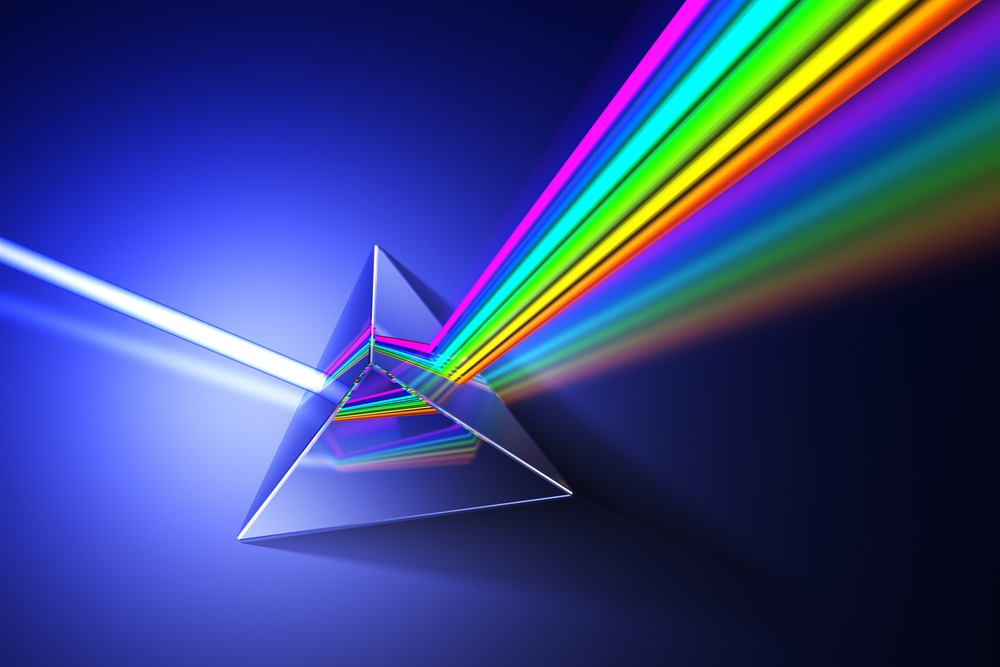
Question 1: Light of different colours is deviated through different angles, by a prism. Explain the reason.
Answer: The angle of deviation produced by a prism depends on the refractive index of the material of prism. The refractive index of material of prism is different for different colours of light because the speed of different colours is different inside the prism. Thus, the light of different colours is deviated through different angles, by a prism.
Question 2: Which colour of white light is deviated most.
Answer: The violet is deviated most.
Question 3: Which colour of white light is deviated least.
Answer: The red light is deviated least.
Question 4: Give reason, why violet colour of white light deviated most and red colour of white light deviated least.
Answer: The reason is that the speed of violet light in glass is least while that of red light is most. Since. Referective index of glass = speed of light in air/speed of light in glass, so the refractive index of glass (the material of prism) is most for violet light and least for red light. Hence, the violet light is deviated most and red light is deviated least.
Question 5: What is understood by the term dispersion of light? What is its cause?
Answer: The splitting of white light into its constituents colours when white light passes through a prism, is called dispersion of light.
The cause of dispersion is the deviation of light of different colours through different angles, by a prism.
Question 6: What is the region beyond the red end of spectrum called?
Answer: Infra red region.
Question 7: In the atmosphere which colour of light gets scattered the least?
Answer: In atmosphere red colour scatters the least.
Question 8: Which characteristic property of light is responsible for the blue colour of the sky?
Answer: Dispersion of light.
Question 9: Write three conditions necessary to obtain a pure spectrum on a screen. Name the instrument in which the conditions stated by you are fulfilled.
Answer: The three conditions necessary to obtain a pure spectrum on a screen are:
(i) A narrow parallel beam of light should be made incident on the prism.
(ii) The prism should be placed in the position of minimum deviation.
(iii) The emergent parallel beam should be focussed on the screen.
These conditions are fulfilled in spectrometer.
Question 10: Name any two electromagnetic waves which have a frequency higher than that of violet light. State one use of each.
Answer: The two electromagnetic waves and their uses having frequency higher than that of violet light is:
X-rays: X-rays are very extensively used for medical purposes, e.g., in surgery to detect bone fractures by studying X-rays photographs.
Gamma rays: Gamma radiations are used in the cure of cancer.
Question 11: How will you investigate the existence of the radiation beyond the red and violet extremes of the spectrum?
Answer: If a blackened bulb thermometer is moved from violet end towards the red end, first a steady rise in temperature is observed, but as the thermometer goes beyond the red end, there is rapid rise in temperature. This shows the existence of some kind of radiation producing the heating effect beyond the red end of the spectrum.
If the radiations from the red end to the violet end are made to fall on the silver chloride solution, it almost remains unaffected beyond the violet end of the spectrum.
Question 12: Name the radiations whose wavelength range is from 100 Å to 4000 Å (or 10 nm to 400 nm).
Answer: UV radiations.
Question 13: Name two sources of ultraviolet radiations.
Answer: (i) Sun, (ii) Electric arc.
Question 14: How can the presence of ultraviolet radiations be detected?
Answer: In presence of ultra-violet radiations, the silver chloride solution becomes dark brown or black.
Question 15: Name two sources of infra red radiations.
Answer: (i) Infra red lamp, (ii) Fire.
Question 16: How can the presence of infrared Radiations be detected?
Answer: In presence of infra red radiations, the temperature recorded by a blackened bulb thermometer rapidly increases.
Question 17: State two properties of infra red radiations which differ from visible light.
Answer: (i) The wavelength of infra red radiations is longer than that of visible light.
(ii) The infra red radiations have more heating effect than that of visible light.
Question 18: State three properties of infra red radiations similar to that of visible light.
Answer: (i) Infrared radiations and visible light both travel in vacuum with a speed 3 × 108 ms-1.
(ii) Both the infra red radiations and the visible light obey the laws of reflection and refraction.
(iii) Both the infra red radiations and the visible light are electromagnetic waves.
Question 19: Infra red radiations are used as signals during war. Explain.
Answer: Infra red radiations, because of their longer wavelength are scattered less by the fog or mist. So they are used as signals during war.
Question 20: State two properties of ultra-violet radiations which differ from visible light.
Answer: (i) Ultra-violet radiations are of wavelength shorter than that of visible light.
(ii) Ultra-violet radiations are more chemically active than the visible light.
Question 21: State two uses of ultraviolet radiations.
Answer: (i) In producing vitamin Din plants.
(ii) For sterilizing purpose.
Question 22: The photographic dark room are provided with infra red lamps. Explain the reason.
Answer: The infra red radiations do not affect the ordinary photographic film, so they are used in the photographic dark room.
Question 23: Explain, why infra red radiations are used for photograpy in fog?
Or
Why are infra-red radiation’s preferred over ordinary visible light for taking photographs in fog?
Answer: Infra-red radiations are used for photography in fog because they are not scattered by fog and can penetrate appreciably through it.
Question 24: State three properties of ultra-violet radiations similar to visible light.
Answer: (i) Ultra-violet radiations can travel in vacuum as the visible light can do, with the speed 3 × 108 ms-1.
(ii) Both the ultra-violet radiations and the visible light are electromagnetic waves.
(iii) Both the ultra-violet radiations and the visible light obey the laws of reflection and refraction.
Question 25: What do you understand by spectrum? Name the seven prominent colours in order, as obtained in the spectrum of white light.
Answer: The spectrum is the colour band obtained on a screen when white light passes through a prism. The seven prominent colours obtained in the spectrum of white light, in order are: Violet, Indigo, Blue, Green, Yellow, Orange, and Red.
Question 26: Distinguish between an impure spectrum and a pure spectrum.
Answer: A spectrum in which there is overlapping of different colours is called an impure Spectrum. In other words, in an impure spectrum, the colours are not distinct and independent but they overlap. On the other hand, a spectrum with each colour distinct and independent is called a pure spectrum.
Question 27: Give one use electromagnetic radiations in Microwaves.
Answer: Microwaves are used for communication.
Question 28: Give one use electromagnetic radiations in Ultraviolet radiation.
Answer: Ultraviolet radiations are used for sterilising purposes.
Question 29: Give one use electromagnetic radiations in Infrared radiation.
Answer: Infrared radiations are used as signals during war.
Question 30: Write the range of wavelength of: (i) the visible spectrum, (ii) the ultraviolet spectrum, and (iii) the infrared spectrum.
Answer: (i) The wavelength range for the visible spectrum is from 4000 Å to 7900 Å.
(ii) The wavelength range for the ultraviolet spectrum is from 100 Å to 4000 Å.
(iii) The wavelength range for the infrared spectrum is from 7900 Å to 107 Å.
Question 31: Write approximate wavelength for (i) blue (ii) red light. Which colour has the higher speed in vacuum? Which colour has the higher speed in glass?
Answer: (i) The wavelength of blue light is nearly 4600 Å.
(ii) The wavelength of red light is nearly 7900 Å.
Both colours have the same speed in vacuum. Red light has the higher speed in glass.
Question 32: Suggest one way, in each case, by which we can detect the presence of Infrared radiations.
Answer: These are detected by a thermopile.
Question 33: Suggest one way, in each case, by which we can detect the presence of Ultraviolet radiations.
Answer: When a silver chloride solution is taken in a test tube and is passed from red to violet light no change is seen. But beyond the violet end the solution first turns violet and then it turns dark brown.
Question 34: Give one use of Infrared radiations.
Answer: Infrared radiations are used in remote control of television.
Question 35: Name the radiations used for detection of fracture in bones.
Answer: X-rays.
Question 36: What is the region beyond the violet end of spectrum called?
Answer: Ultra-violet region.
Question 37: Name the radiation of wavelength longer than 8 × 10-7 m.
Answer: Infra red radiations.
Question 38: State two uses of infrared radiations.
Answer: (i) For therapeutic purpose.
(ii) In night photography.
Question 39: What effect do the ultra-violet radiations have on the human body?
Answer: The ultra-violet radiations cause skin diseases on the human body.
Question 40: Explain, why quartz prism is required for obtaining the spectrum of ultra-violet light?
Answer: The reason is that glass absorbs the ultra-violet radiations while the quartz does not absorb them.
Question 41: Rock salt prism is used instead of glass prism to obtain the infra red spectrum. Give reason.
Answer: The reason is that glass absorbs the infra red radiations while the rocksalts does not absorb them.
Question 42: Name the radiations that are used for photography at night.
Answer: Infrared radiations.
Long Answers
Question 1: A prism causes dispersion of white light while a rectangular glass block does not. Explain.
Answer: In a prism, the refraction of light takes place at the two slant surfaces. The dispersion of white light occurs at the first surface of prism where its constituent colours are deviated through different angles. At the second surface, these splitted colours suffer only refraction and they get further separated. But in a rectangular glass block, the refraction of light takes place at the two parallel surfaces. At the first surface, although the white light splits into its constituent colours on refraction, but these splitted colurs on suffering refraction at the second surface emerge out in form of a parallel beam, which give an impression of white light.
Figure Based Short Answers
Question 1: Sunlight entering through a narrow aperture falls on a prism. Draw a neat labelled ray diagram to show the formation of spectrum on a screen. Name the colour obtained nearer the base of the prism.
Answer:
The labelled ray diagram showing the formation of spectrum of sunlight on a screen is given below. The colour obtained nearer the base of the prism is violet.
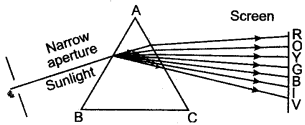
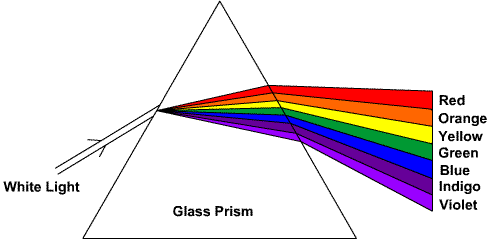
Question 2: In the figure (i) and (ii) a beam of light consisting of three colours blue, red and yellow is incident on a prism and on a rectangular glass block respectively. Complete the diagrams by drawings the refracted and emergent rays.
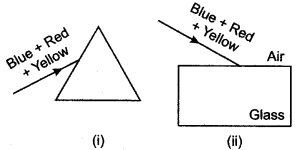
Answer:
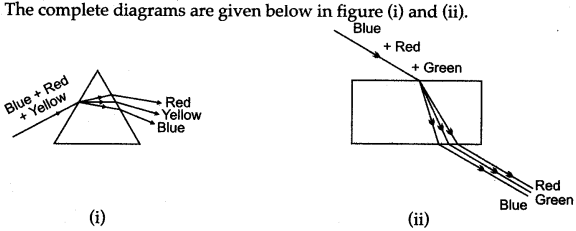
Question 3: In the diagram a narrow beam of white light is incident on a right angled isosceles prism. The critical angle of the material of prism for yellow colour of white light is 45°. Complete the diagram to show the path of blue, yellow and red colours of white light till they emerge out of the prism.
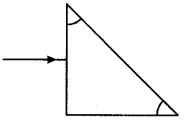
Answer: The completed diagram is shown below:

The critical angle for yellow light is given to be 45°. Since μblue > μyellow and μred < μyellow so the critical angle for blue light will be less than 45° and for red light will be more than 45°.
Question 4: Draw a neat diagram to show the arrangement you would use to project a pure spectrum of white light on a screen.
Answer: The diagram is shown below:

Figure Based Long Answers
Question 1: Comment on the statement: ‘When any ray of white light is incident on a glass prism, it simply disperses it into its seven constituent colours.
Answer: Before making any comment, the following simple experiment should be performed.
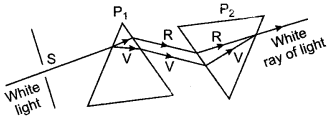
Arrangement is shown in the diagram. P1 and P2 are two glass prisms exactly similar and placed at some distance from each of the such that their refracting surfaces are parallel to each other and the base of the prism P2 is upwards and vertex downwards. S is a narrow slit through which a ray of white light is incident on the refracting face of the prism P1. It is dispersed by it into its seven constituent colours.
When this dispersed light falls on the refracting surface of the prism P2, having its base upwards so that the rays are deviated in a direction different from the first, we see on the screen only a white spot of light. It is evident that the second prism P2 recombines these colours to form white light acting as a ‘recombination prism’ while the first prism acts as a ‘dispersing prism’.
Question 2: An imaginary material reflects red light, scatters green light, transmits blue light and absorbs yellow, orange and violet light. A cube of this material is shown in the given diagram.
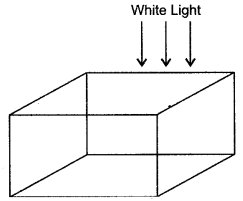
The surface is illuminated with a beam of white light. What colour will this cube appear (i) from above, (ii) from below and (iii) from the sides?
Answer: When viewed from above — Red.
When viewed from above — Blue.
When viewed from above — Green.
Short Numericals
Question 1: What is the wavelength of the wave whose frequency is 1012 Hz? Name the electromagnetic wave.
Solution:

These waves are heat waves or infra-red waves whose wavelength varies from 10-2 to 10-4 cm.
For More Resources
